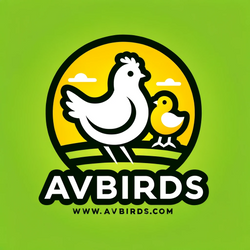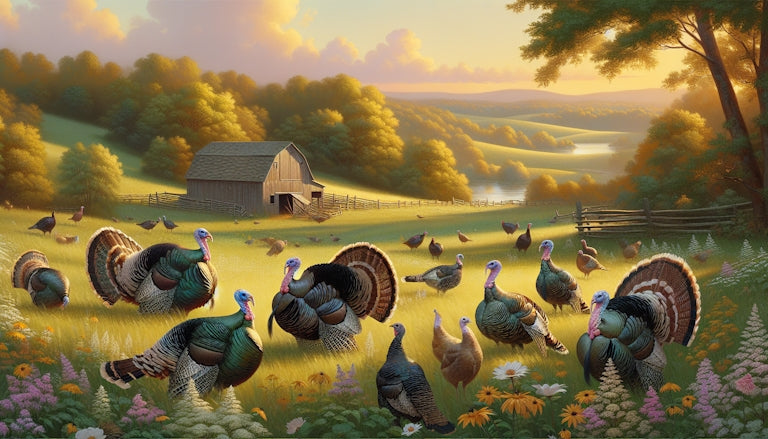Understand Heritage Turkeys
If you want to bring real flavor and sustainability to your farm, consider heritage turkey breeds. These traditional birds offer slow growth, robust health, and a taste that outshines mass-produced turkeys. Want to know why these birds are making a comeback? In this guide, you’ll learn how to pick the right heritage turkey for your homestead, raise healthy poults, and support breed diversity.
Defining Heritage Birds
Heritage turkeys come from traditional, nonindustrial stock. They grow slowly, mate naturally, and live outdoors. Hens lay eggs for 5 to 7 years, and toms remain productive for 3 to 5 years. You’ll spot diverse colors and patterns, including Bourbon Red, Black Spanish, and Royal Palm (The Livestock Conservancy). These birds forage well, resist stress, and adapt to changing climates.
Heritage Turkey History
Early American farmers crossed European stock with wild turkeys in the 1600s. That mix led to the Narragansett variety in Rhode Island. In the 1830s, breeders near Point Judith developed the Bronze turkey, later the template for commercial lines. By the 1950s, Broad Breasted White birds dominated industrial farms but lost natural mating ability and require artificial insemination today (The Livestock Conservancy). Small-scale stewards preserved true heritage strains, and now they’re enjoying a renaissance on sustainable farms.
Benefits of Heritage Breeds
Raising heritage turkeys comes with perks you won’t get from factory-bred birds. Here’s what makes them special.
Flavor and Texture
Here’s the thing, heritage birds taste amazing. Their slower growth builds firmer, more flavorful meat. You get a balanced ratio of white and dark meat thanks to a body shape closer to wild turkeys. Chocolate Heritage Turkeys, for example, sport a dark milk chocolate hue that’s as rich as their flavor (Murray McMurray Hatchery). Guests will notice deeper color and a cleaner dress, so prep time drops too.
Health and Immunity
Small-scale trials show heritage lines have stronger immune systems than industrial strains. The Livestock Conservancy’s 2004–2006 research found heritage turkeys resist common diseases better, which means fewer vet visits and less medication (The Livestock Conservancy). Their natural foraging habits also lower stress for birds and land.
Environmental Advantages
Raising heritage turkeys supports biodiversity on your farm. These free-ranging birds roam fields much like free range chickens, controlling pests naturally and reducing supplemental feed. Their diverse genetics help protect against climate swings. By choosing heritage stock, you promote sustainable grazing, enrich soil health, and foster a balanced ecosystem.
Popular Heritage Varieties
Below is a snapshot of some top heritage turkey breeds and what makes each one shine.
Source: Murray McMurray Hatchery
| Breed | Tom Weight (lbs) | Conservation Status | Traits |
|---|---|---|---|
| Bourbon Red | ~23 | Recovering | Chestnut plumage, compact build |
| Black Spanish | ~23 | Threatened | Calm temperament, rapid gain |
| Blue Slate | 23–27 | Threatened | Mexican origin, good rate of gain |
| Chocolate | up to 33 | Watch | Dark coloring, gentle nature |
| Midget White | ~20 | Watch | Small size, tender meat |
Raise Heritage Turkeys
Heritage turkeys need a bit more time and care than broad-breasted birds, but the payoff is worth every step.
Brooder and Housing Needs
- Start poults in a heated brooder at 95°F, dropping temperature by 5°F each week.
- Offer 2 square feet per bird under cover, plus an outdoor run when they’re feathered.
- Use absorbent bedding like pine shavings and swap it out weekly.
- Gear up with proper chick brooder supplies for their first month.
Feeding and Nutrition
- Provide a high-protein starter feed (28%) for the first 8 weeks.
- Transition to a grower ration (18% protein) until about 20 weeks.
- Give access to pasture or a large run for natural foraging.
- Supplement with grit and oyster shell for healthy digestion and strong shells.
Health and Management
- Inspect poults daily for pasty butt, leg weakness, and respiratory issues.
- Keep feeders and waterers clean to prevent bacterial buildup.
- Vaccinate chicks if available through your hatchery—ask about vaccinated chicks options.
- Rotate pens yearly to manage parasites and maintain soil health.
Growth Timeline
Heritage turkeys take 24–30 weeks to reach market weight, compared to about 18 weeks for commercial birds. You’ll aim for 26–28 weeks for most breeds, giving muscles time to develop flavor (Heritage Turkey Foundation). Patience pays off at the dinner table.
Buy Heritage Poults
Getting your hands on true heritage poults can be simpler than you think.
Where To Find Poults
Start with reputable hatcheries or small-scale farms. Many list availability online, but if you prefer eggs, check hatching eggs for sale. For ready-to-go birds, browse our turkey poults for sale listings.
Evaluating Quality
- Ask about parent stock health, vaccination history, and breeding practices.
- Look for uniform size and alert behavior in poults.
- Confirm hatch dates are within a 24-hour window to ensure even growth.
Ordering Tips
- Plan orders early—heritage poults often sell out fast.
- Check minimum order requirements—some hatcheries offer minimum order chicks and poults.
- Arrange shipping in moderate weather, using a service experienced with live birds.
- Have your brooder ready on delivery day to minimize stress.
Support Breed Diversity
Beyond your farm gate, you can help keep heritage lines thriving.
Conservation Efforts
The Heritage Turkey Foundation and The Livestock Conservancy work to protect endangered breeds. You can join by purchasing from approved growers, donating to breed rescues, or volunteering at local poultry events (Heritage Turkey Foundation, The Livestock Conservancy).
Community and Resources
- Connect with fellow keepers on forums and social media groups.
- Use tools like our breed selector to find poultry that suits your goals.
- Attend workshops or farm tours to learn hands-on skills.
- Share your success by tagging #HeritageTurkeys on social channels.
Heritage Turkey Key Takeaways
- Heritage turkey breeds grow slowly, mate naturally, and live productively for years.
- You’ll enjoy richer flavor, firmer texture, and balanced white/dark meat.
- Stronger immunity and foraging habits lower health costs and environmental impact.
- Plan housing, feeding, and health care around a 26–28 week growth cycle.
- Source quality poults early and support credible hatcheries or local farms.
- Join conservation efforts to protect these historic lines for future generations.
Ready to add heritage turkeys to your farm? Check out our turkey poults for sale to get started. Have questions or tips? Drop a comment below so we can all learn and grow together.

